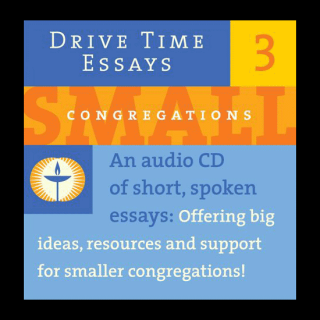Change in Small Congregations: A Drive Time Essay
By Kenneth Brown

Drive Time Essays Volume 3: Small Congregations
Learn More
Change is always difficult, yet it happens every day in our lives in small and big ways. It is also is a regular component of congregational life. When a visitor shows up on a Sunday, the dynamics in a congregation have changed, particularly if the newcomer stays. We all need to be aware of the small changes, but the leadership needs to plan for the bigger changes, like finding a new meeting space, calling the first minister, changing the time of the worship service. In small congregations the impact of such change can be more immediate and problematic. Thus it is vitally important for the leadership of small congregations to plan for such change. Having a clear shared mission on which the congregation can build change is the beginning. Any change of import must be based on a plan that helps fulfill the congregation’s mission.
William Bridges suggests, in his book Managing Transitions, that it is not the change that impacts organizations like congregations, it is the transition. Once the plan for a change becomes clear to those in charge of the planning, the leaders need to plan for the transition. Too often the leaders of any change try to push or pull people into the change without allowing for the transition that people must go through.
Bridges states that change is external, representing the different practice, structure, or policy that a congregation faces. The transition is internal; it is what impacts people; it is the psychological reorientation that people go through that leads to the change. There are three different processes that a congregation moves through to get to the change.
The first is saying good-bye to whatever must be given up in order to move toward the change. Leaders need to be in conversation in multiple ways with congregational members, to listen to their feelings and to help them understand that any change means that some ways of doing things will end. Only by listening to congregational members can you help people understand that while they may be giving up something they love, by moving to a new site, for instance, or bringing in a new minister, that there are other things that will be gained that will help the congregation achieve its mission.
The second step in the transition involves helping people move into the neutral zone. Even after people have become willing to let go of the way things were done in the past, they are not immediately able to start anew. Bridges suggests that the neutral zone is the place where people can process their feelings and begin to understand how the change will help them and the congregation achieve their mission. This may be an uncomfortable phase but the wise leader allows space for people to sit with the impact of the change. The wise leader will not push people into the third stage but will let them work things through and calmly answer people’s questions.
The last stage is moving forward into what Bridges calls “the new beginning.” Moving into this stage means that people have worked through enough of their emotions and questions to accept the change. The trick is to recognize that not everyone will move to stage three; in fact, at any given time some folks will not move out of stage one. Leadership needs to recognize this fact of community life and still move ahead.
One problem in many congregations, particularly small congregations, is that we allow a few people block a change that has been well thought out and fits with the congregation’s mission. This last step of communicating with those who insist on not moving into the third stage is crucial. We need to say to these people that while we care about them, the congregation is moving forward, and we hope they will move with us, but if they cannot we understand. You might even suggest they take time off for a while but if they have to leave you understand. Leadership cannot be held hostage by a few people. Threats of withholding pledges, quitting the congregation, or other such actions should not prevent a congregation from moving forward. This is difficult in small congregations where people feel they cannot lose any members. But if a congregation is to survive into the future such choices must be made.
Transition work leaders must also recognize that the more time one spends on managing the various stages, the longer it will take to move to the new beginning. Yet if the leadership is willing to take this time, the change will be easier in the long run.
Change is part of being human, part of any congregation. Taking time to understand transition is very important for making change in our congregations. If you want to learn more about the work of William Bridges, you can read his book Managing Transitions, from Perseus Publishers. Also remember that your District staff understands the role of transitions in congregational life and may be able to help your congregation in such situations.
About this Essay
Audio Essay Series: Volume 3: Small Congregations, Track 9 (MP3, 5:53 minutes)
About the Drive Time Essay Series
This Audio Essay series was created by the Unitarian Universalist Association of Congregations, for the purpose of supporting its valued lay leaders. Copying and sharing these essay texts, downloadable audio files, and the companion Lay Leader Drive Time Essays compact disc is welcomed and encouraged.